Uvsq-Sat NG, a New CubeSat Pathfinder for Monitoring Earth Outgoing Energy and Greenhouse Gases
Abstract
1. Introduction
2. Scientific Objectives
2.1. Earth’s Radiation Budget
2.2. Carbon Dioxide and Methane
3. Description of the Uvsq-Sat NG Space-Based Mission
3.1. Description of the Uvsq-Sat NG Satellite and Its Payloads
3.2. Calibration and Validation—Cal/Val
- Pre-Launch Calibration: Before Uvsq-Sat NG is launched, its payloads (ERSs, NIR Spectrometer, and NanoCam) will be calibrated in controlled laboratory conditions in a clean-room class 1000. Calibration involves exposing the instruments to known physical parameters, such as temperature, radiation, and light sources, and comparing the instrument’s response to the expected values. In this stage, reference standards are used to determine the instrument’s sensitivity, linearity, and accuracy.
- Pre-Launch Validation: It encompasses testing and validating the satellite’s data processing algorithms through simulated data and mimicking real-world measurements, processed with mission algorithms and compared against known outcomes for data processing accuracy.
- In-Orbit Calibration: Following its launch and early operations, In-Orbit Calibration is conducted to optimize the instrument’s calibration. This involves using internal calibration sources (laser light source for the Uvsq-Sat NG Spectrometer calibration, for instance) or external known references (Sun, Moon, stars, use of the Lunar Laser facility at Calern (Observatoire de la Côte d’Azur, France), or specific Earth locations, such as Palm Jumeirah in the United Arab Emirates, for satellite instrument calibration). The calibration coefficients are validated and adjusted as needed by comparing the In-Orbit Calibration data with the Pre-Launch Calibration results.
- In-Orbit Validation: Once the satellite is operational, its data undergo validation through a comparison with measurements taken from models, ground-based measurements, or data from other satellite missions. This process will be implemented to validate the quality and consistency of the future Uvsq-Sat NG data. Cross-validation with data from independent sources is essential for establishing the credibility of the Uvsq-Sat NG measurements and for detecting any potential biases or errors.
3.2.1. ERSs for Ongoing ERB Measurements from Uvsq-Sat and Inspire-Sat 7
3.2.2. Uvsq-Sat NG NIR Spectrometer for Monitoring GHG Concentrations in the Atmosphere
- The characterization of the spectrometer’s pixels to accurately deduce the incident irradiance based on the digital signal output from specific pixels. This is to be performed because each pixel of the InGaAs linear image sensor of the Uvsq-Sat NG Spectrometer has a specific dark current, dark offset, and gain and might respond non-linearly to change in irradiance.
- Photosensitivity and Quantum Efficiency (QE) as a function of wavelength of each pixel to be able to convert digital signal from the InGaAs linear image sensor of the Uvsq-Sat NG Spectrometer into input irradiance at a given wavelength.
- The Measurement of Spectral Response Function (SRF) of the Uvsq-Sat NG Spectrometer to assess the weighting of a continuous light source via sensor response. This test will be performed using the LATMOS/OVSQ iHR320 monochromator (Horiba, Palaiseau, France), equipped with a holographic grating in the spectral range of 400–1300 nm (1200 grove/mm, blaze wavelength of 630 nm) and a ruled grating in the spectral range of 1000–2500 nm (600 g/mm, blaze wavelength of 1500 nm). The iHR320 monochromator will be positioned before an NIR lamp that requires cooling. At the exit of the iHR320 monochromator, a beamsplitter will divide the light, directing it towards both the Uvsq-Sat NG Spectrometer and a sensor reference.
- The absolute calibration of the Uvsq-Sat NG Spectrometer using secondary standards for spectral irradiance. For this measurement, an absolute reference lamp will be placed directly in front of the Uvsq-Sat NG Spectrometer. To eliminate stray light, a mask will be used between the spectrometer and the lamp. A test will also be conducted at PTB to validate the absolute measurements.
- The verification of the inverse square law for confirming the principle that the intensity of light from a source decreases as the square of the distance from the source increases.
- The Bidirectional Reflectance Distribution Function (BRDF) and angular responses that help us to predict how light will be reflected or transmitted at varying angles.
- The characterization of the stray light, which is essential for maintaining the sensitivity, dynamic range, and spectral resolution of the Uvsq-Sat NG Spectrometer.
- Thermal characterization efforts will be included to examine how the Uvsq-Sat NG NIR Spectrometer’s response varies with temperature.
3.2.3. Uvsq-Sat NG NanoCam for Observing the Earth in the Visible Range
3.2.4. Pre-Launch Validation of the ADCS
3.3. Concept of Operations—ConOps
- Pre-Launch Phase: The ConOps starts with a clear statement of the satellite’s mission objectives, including its communication and education goals (Mission Objectives). Detailed requirements for the satellite system, payloads, and ground infrastructure are identified and documented (System Requirements). The satellite system, including the spacecraft bus, payloads, power subsystem, communication subsystem, and ADCS, is designed and integrated (System Design). This is the current status of the Uvsq-Sat NG mission as of September 2023. The upcoming tasks to be completed include full satellite integration and initial functional testing, environmental testing (vibration, thermal vacuum thermal cycling), ADCS validation, Pre-Launch Cal/Val, magnetic cleanliness verification of the satellite, software testing, communication tests, as well as power and energy testing. Additional tasks should be completed, including a possible satellite test in a vacuum chamber using an external Heliostat to redirect solar light onto Uvsq-Sat NG. This phase will conclude with the final checks and inspections of Uvsq-Sat NG, launch readiness review, and launch campaign planning.
- Launch and Early Operations: The satellite will be launched into orbit using Falcon 9, Vega-C, Zéphyr or a similar rocket launcher. The final choice has not been determined yet. For Early Operations in orbit, the satellite’s subsystems will be initialized and checked to ensure they are functioning as expected in ’INIT’ Mode. The satellite’s position and orbit will be determined accurately using our ground-based tracking stations (Hermès and Elsa). Based on our experience, we will feature an automated procedure for its Early Operations. The following chronological steps will be implemented:
- −
- From T0 to T0 + 30 min: deployment of the two solar panels, deployment of the UHF/VHF antennas, and deployment of the main Uvsq-Sat NG magnetometer.
- −
- At T0 + 40 min: The satellite switches to ’Detumbling’ mode by relying on its ADCS. The iMTQ board is activated for 10 min to stabilize the CubeSat.
- −
- At T0 + 45 min: The satellite switches to ’Stand-by mode’ and awaits the first Tele-Command (TC) from the LATMOS ground station. If no TC is received within 4 days, the initialization procedure restarts in ’debugging’ mode (UHF/VHF antennas deployment), repeated every 4 days until the first TC is received.
- −
- At T0 + 4 days: the satellite switches to ’Nominal mode’ using a TC from the LATMOS ground stations.
- Nominal Operations: The satellite establishes communication links with ground stations to downlink data and receive commands for mission operations (Communication). The ADCS is used to maintain the satellite’s desired orientation (Nadir Pointing Mode) for optimal data collection (Attitude Control). The Uvsq-Sat NG payloads are switched on for collecting data according to the mission’s scientific or observation plan (Payloads Operation). Telemetry data, including the satellite’s health status, are continuously transmitted to the ground stations, while commands from the ground are sent to the satellite for various operations (Telemetry and Command).
- Calibration Operations: The ADCS is active during these operations. The payloads operate according to several ADCS modes (Ground Point Tracking Mode, Sun Tracking Mode, Earth’s limb, deep space). Sequences of rapid satellite rotation are planned to study the significance of atmospheric effects on ECVs measurements and to correct the data. Other observations such as Boresight Solar Zenith Angle or Pitch Angle Adjustment are planned. Lastly, the optimization campaigns of the Uvsq-Sat NG Spectrometer are scheduled, focusing on SNR versus exposure time measurements.
- Anomaly Detection and Recovery: The satellite’s systems continuously monitor for any anomalies or deviations from expected behavior, and any anomalies are quickly identified (Anomaly Detection). Procedures are in place to diagnose and recover from anomalies, including contingency plans for different scenarios (Anomaly Recovery).
- End of Mission: A plan for end-of-life Uvsq-Sat NG disposal is executed to prevent orbital debris. Using the Damocles unit, the satellite must be passivated, ensuring that no energy sources (batteries) can disrupt or contaminate outer space.
- Ground Segment: A network of ground stations is established to communicate with the satellite and collect data (ground stations from LATMOS and ACRI-ST). A dedicated facility manages all aspects of satellite operations, including commanding, monitoring, and data processing (Mission Operations Center from LATMOS and ACRI-ST). A LATMOS scientific facility is responsible for managing and coordinating the scientific operations and activities of the Uvsq-Sat NG educational and scientific mission (Scientific Operations Center).
- Regulatory Compliance: The ConOps ensures that the Uvsq-Sat NG mission adheres to all relevant international space treaties, national regulations (Loi des Opérations Spatiales (LOS)—French Space Operations Act), and space debris mitigation guidelines.
4. Methodology for Determining ERB and GHGs with Uvsq-Sat NG
- —Step 1—
- Recovering the atmospheric transmittance functions data files (CO, CH, O, HO at different concentrations). NIR transmission spectra are simulated using the High-Resolution Transmission Molecular Absorption (HITRAN) Database [31]. Spectra are computed at very high resolution ( = 0.005 cm) in the wavenumber () interval 4500 to 10,000 cm. For CO, CH, and O that are well mixed in the atmosphere, the pressure (P) is set to 500 hPa, which represents an average value between the bottom and the top of the atmosphere. For HO, which is more abundant in the lower atmospheric layers, the pressure is set to 800 hPa. The temperature (T) is 250 K and a Voigt profile is considered for the HITRAN simulation. The optical path of length (L) of the simulation is different for each gas (for instance, under nominal mixing conditions, the values considered are 6.228 m for CO, 0.028 m for CH, 3113.840 m for O, and 16.161 m for HO). The absorption coefficient () is used for each gas. It represents a normalization of the absorption coefficient by the number N (cm) of absorbing molecules per unit gas volume. The dimensionless transmittance function () for each gas is given by Equation (1).
- —Step 2—
- Normalization and convolution of atmospheric data to the Uvsq-Sat NG Spectrometer’s resolution. The data series are normalized, taking into account the Solar Zenith Angle () and the satellite pointing axis () between the Nadir and the Zenith (Equation (2)), as depicted in the diagram illustrated in Figure 3.
- —Step 3—
- Determination of the total dimensionless resulting transmittance function from the considered values of the gas mixing ratio. The total dimensionless resulting transmittance function (, simplified to ) is obtained from Equation (4). It depends on the desired mixing ratio, the nominal mixing ratio and the ’maximum’ mixing ratio of each gas.
- —Step 4—
- Determination of the Uvsq-Sat NG NIR Spectrometer theoretical normalized dimensionless transmittance function. The Uvsq-Sat NG NIR Spectrometer has its own instrumental characteristics and a SNR that limit its performance. The ’true’ dimensionless signal that will be observed ( in this scenario) will therefore be affected by the observations made via the spectrometer. In order to assess the anticipated performance of the Uvsq-Sat NG NIR Spectrometer, Gaussian noise is subsequently introduced to the simulated spectra () prior to conducting the Levenberg–Marquardt spectral inversion. This inversion is performed while considering an adjustable SNR within the range of 50 to 5000. Equation (5) allows us to determine the dimensionless signal () as it can be observed via the Uvsq-Sat NG NIR Spectrometer, considering its spectral resolution (between 1 and 6 nm) and SNR (around 2000, which would correspond to an excellent value).
- —Step 5—
- Utilization of the Levenberg–Marquardt algorithm to determine normalized coefficients , , , and , which correspond to the concentrations of the four gases as they could be observed via the Uvsq-Sat NG Spectrometer. From the dimensionless signal (), the interpolation coefficients (, , , and ) are determined using the Levenberg–Marquardt algorithm, which is commonly used for solving non-linear least squares problems. Here is a description of the method:
- Initialization: Start with an initial estimate of the interpolation coefficients , , , and (all values are set to 1), as well as the parameter (regularization factor). Choose a starting value for (typically a small value).
- Residual Calculation: Use the current interpolation coefficients to calculate the model predictions. Then, subtract these predictions from the observed data to obtain the residuals.
- Jacobian Matrix Calculation: It represents the partial derivatives of the residuals with respect to the interpolation coefficients. It quantifies how each coefficient contributes to the residuals.
- Hessian Matrix Calculation: Calculate the Hessian matrix, which is the second derivative matrix of the residuals with respect to the coefficients. It helps adjust the weighting between the model terms and regularization.
- Coefficient Update Calculation: Calculate the coefficient update using the formula of the Levenberg–Marquardt algorithm:where J is the Jacobian matrix and R is the residuals function. The helps to enhance and stabilize the matrix, while noise will be incorporated into R.
- Evaluation of Improvement: Calculate the potential improvement by comparing the norm of residuals before and after the coefficient update. If the improvement is significant, accept the update. Otherwise, adjust and repeat.
- Iterative Repetition: Repeat stages 2 (Initialization) through 6 (Evaluation of Improvement) until the residuals either converge to a minimum or meet a stopping criterion. Such criteria can include reaching a maximum number of iterations or observing only minor variations in the coefficients.
- —Step 6—
- Quantification of uncertainties on the concentrations of gases as they can be observed via the Uvsq-Sat NG NIR Spectrometer (Figure 7).
5. Conclusions
Author Contributions
Funding
Data Availability Statement
Acknowledgments
Conflicts of Interest
References
- Friedlingstein, P.; O’Sullivan, M.; Jones, M.W.; Andrew, R.M.; Gregor, L.; Hauck, J.; Le Quéré, C.; Luijkx, I.T.; Olsen, A.; Peters, G.P.; et al. Global Carbon Budget 2022. Earth Syst. Sci. Data 2022, 14, 4811–4900. [Google Scholar] [CrossRef]
- McCarthy, M.P.; Best, M.J.; Betts, R.A. Climate change in cities due to global warming and urban effects. Geophys. Res. Lett. 2010, 37, L09705. [Google Scholar] [CrossRef]
- Lamb, W.F.; Wiedmann, T.; Pongratz, J.; Andrew, R.; Crippa, M.; Olivier, J.G.J.; Wiedenhofer, D.; Mattioli, G.; Khourdajie, A.A.; House, J.; et al. A review of trends and drivers of greenhouse gas emissions by sector from 1990 to 2018. Environ. Res. Lett. 2021, 16, 073005. [Google Scholar] [CrossRef]
- Stephens, G.L.; Li, J.; Wild, M.; Clayson, C.A.; Loeb, N.; Kato, S.; L’Ecuyer, T.; Stackhouse, P.W.; Lebsock, M.; Andrews, T. An update on Earth’s energy balance in light of the latest global observations. Nat. Geosci. 2012, 5, 691–696. [Google Scholar] [CrossRef]
- Rising, J.; Tedesco, M.; Piontek, F.; Stainforth, D.A. The missing risks of climate change. Nature 2022, 610, 643–651. [Google Scholar] [CrossRef]
- Douville, H. Robust and perfectible constraints on human-induced Arctic amplification. Commun. Earth Environ. 2023, 4, 283. [Google Scholar] [CrossRef]
- Bryce and Space Technology. SmallSat by the Numbers. 2022. Available online: https://brycetech.com/reports/report-documents/Bryce_Smallsats_2022.pdf (accessed on 28 September 2022).
- Meftah, M.; Damé, L.; Keckhut, P.; Bekki, S.; Sarkissian, A.; Hauchecorne, A.; Bertran, E.; Carta, J.P.; Rogers, D.; Abbaki, S.; et al. UVSQ-SAT, a Pathfinder CubeSat Mission for Observing Essential Climate Variables. Remote Sens. 2019, 12, 92. [Google Scholar] [CrossRef]
- Meftah, M.; Boust, F.; Keckhut, P.; Sarkissian, A.; Boutéraon, T.; Bekki, S.; Damé, L.; Galopeau, P.; Hauchecorne, A.; Dufour, C.; et al. INSPIRE-SAT 7, a Second CubeSat to Measure the Earth’s Energy Budget and to Probe the Ionosphere. Remote Sens. 2022, 14, 186. [Google Scholar] [CrossRef]
- Meftah, M.; Boutéraon, T.; Dufour, C.; Hauchecorne, A.; Keckhut, P.; Finance, A.; Bekki, S.; Abbaki, S.; Bertran, E.; Damé, L.; et al. The UVSQ-SAT/INSPIRESat-5 CubeSat Mission: First In-Orbit Measurements of the Earth’s Outgoing Radiation. Remote Sens. 2021, 13, 1449. [Google Scholar] [CrossRef]
- Wielicki, B.A.; Barkstrom, B.R.; Harrison, E.F.; Lee, R.B., III; Smith, G.L.; Cooper, J.E. Clouds and the Earth’s Radiant Energy System (CERES): An Earth Observing System Experiment. Bull. Am. Meteorol. Soc. 1996, 77, 853–868. [Google Scholar] [CrossRef]
- Pilewskie, P.; Hakuba, M.; Stephens, G. The Future of Earth Radiation Budget Observations Beyond CERES: Libera and Continuity of the ERB Climate Data Record. In Proceedings of the EGU General Assembly Conference Abstracts, Vienna, Austria, 23–28 April 2023. No. EGU–17097. [Google Scholar] [CrossRef]
- von Schuckmann, K.; Palmer, M.D.; Trenberth, K.E.; Cazenave, A.; Chambers, D.; Champollion, N.; Hansen, J.; Josey, S.A.; Loeb, N.; Mathieu, P.P.; et al. An imperative to monitor Earth’s energy imbalance. Nat. Clim. Chang. 2016, 6, 138–144. [Google Scholar] [CrossRef]
- Loeb, N.G.; Johnson, G.C.; Thorsen, T.J.; Lyman, J.M.; Rose, F.G.; Kato, S. Satellite and Ocean Data Reveal Marked Increase in Earth’s Heating Rate. Geophys. Res. Lett. 2021, 48, e93047. [Google Scholar] [CrossRef]
- Loeb, N.; Thorsen, T.; Ham, S.H.; Rose, F.; Kato, S. Observational Assessment of Changes in Earth’s Energy Imbalance Since 2000. In Proceedings of the EGU General Assembly Conference Abstracts, Vienna, Austria, 23–28 April 2023. No. EGU–2962. [Google Scholar] [CrossRef]
- Burrows, J.; Hölzle, E.; Goede, A.; Visser, H.; Fricke, W. SCIAMACHY—Scanning imaging absorption spectrometer for atmospheric chartography. Acta Astronaut. 1995, 35, 445–451. [Google Scholar] [CrossRef]
- Bovensmann, H.; Burrows, J.P.; Buchwitz, M.; Frerick, J.; Noël, S.; Rozanov, V.V.; Chance, K.V.; Goede, A.P.H. SCIAMACHY: Mission Objectives and Measurement Modes. J. Atmos. Sci. 1999, 56, 127–150. [Google Scholar] [CrossRef]
- Kuze, A.; Kikuchi, N.; Kataoka, F.; Suto, H.; Shiomi, K.; Kondo, Y. Detection of methane emission from a local source using GOSAT target observations. Remote Sens. 2020, 12, 267. [Google Scholar] [CrossRef]
- Janardanan, R.; Maksyutov, S.; Tsuruta, A.; Wang, F.; Tiwari, Y.K.; Valsala, V.; Ito, A.; Yoshida, Y.; Kaiser, J.W.; Janssens-Maenhout, G.; et al. Country-scale analysis of methane emissions with a high-resolution inverse model using GOSAT and surface observations. Remote Sens. 2020, 12, 375. [Google Scholar] [CrossRef]
- Chen, Y.; Cheng, J.; Song, X.; Liu, S.; Sun, Y.; Yu, D.; Fang, S. Global-Scale Evaluation of XCO2 Products from GOSAT, OCO-2 and CarbonTracker Using Direct Comparison and Triple Collocation Method. Remote Sens. 2022, 14, 5635. [Google Scholar]
- Jacob, D.J.; Varon, D.J.; Cusworth, D.H.; Dennison, P.E.; Frankenberg, C.; Gautam, R.; Guanter, L.; Kelley, J.; McKeever, J.; Ott, L.E.; et al. Quantifying methane emissions from the global scale down to point sources using satellite observations of atmospheric methane. Atmos. Chem. Phys. 2022, 22, 9617–9646. [Google Scholar] [CrossRef]
- Pasternak, F.; Bernard, P.; Georges, L.; Pascal, V. The microcarb instrument. In Proceedings of the International Conference on Space Optics— ICSO 2016, Biarritz, France, 18–21 October 2016; Cugny, B., Karafolas, N., Sodnik, Z., Eds.; International Society for Optics and Photonics, SPIE: Bellingham, WA, USA, 2017; Volume 10562, p. 105621P. [Google Scholar] [CrossRef][Green Version]
- Mayorova, V.; Morozov, A.; Golyak, I.; Golyak, I.; Lazarev, N.; Melnikova, V.; Rachkin, D.; Svirin, V.; Tenenbaum, S.; Vintaykin, I.; et al. Determination of Greenhouse Gas Concentrations from the 16U CubeSat Spacecraft Using Fourier Transform Infrared Spectroscopy. Sensors 2023, 23, 6794. [Google Scholar] [CrossRef]
- Jallad, A.H.; Marpu, P.; Abdul Aziz, Z.; Al Marar, A.; Awad, M. MeznSat—A 3U CubeSat for Monitoring Greenhouse Gases Using Short Wave Infra-Red Spectrometry: Mission Concept & Analysis. Aerospace 2019, 6, 118. [Google Scholar] [CrossRef]
- Sperfeld, P.; Metzdorf, J.; Galal Yousef, S.; Stock, K.D.; Möller, W. Improvement and extension of the black-body-based spectral irradiance scale. Metrologia 1998, 35, 267. [Google Scholar] [CrossRef]
- Sperfeld, P.; Galal Yousef, S.; Metzdorf, J.; Nawo, B.; Möller, W. The use of self-consistent calibrations to recover absorption bands in the black-body spectrum. Metrologia 2000, 37, 373. [Google Scholar] [CrossRef]
- Kuze, A.; Suto, H.; Nakajima, M.; Hamazaki, T. Thermal and near infrared sensor for carbon observation Fourier-transform spectrometer on the Greenhouse Gases Observing Satellite for greenhouse gases monitoring. Appl. Opt. 2009, 48, 6716–6733. [Google Scholar] [CrossRef] [PubMed]
- Meftah, M.; Damé, L.; Bolsée, D.; Hauchecorne, A.; Pereira, N.; Sluse, D.; Cessateur, G.; Irbah, A.; Bureau, J.; Weber, M.; et al. SOLAR-ISS: A new reference spectrum based on SOLAR/SOLSPEC observations. A&A 2018, 611, A1. [Google Scholar] [CrossRef]
- Meftah, M.; Sarkissian, A.; Keckhut, P.; Hauchecorne, A. The SOLAR-HRS New High-Resolution Solar Spectra for Disk-Integrated, Disk-Center, and Intermediate Cases. Remote Sens. 2023, 15, 3560. [Google Scholar] [CrossRef]
- Meftah, M.; Sarkissian, A.; Reberac, A. SOLAR-HRS: The HRS High-Resolution Extraterrestrial Solar Reference Spectra for Disk-Integrated, Disk-Center, and Intermediate Cases; LATMOS: Paris, France, 2022. [Google Scholar] [CrossRef]
- Gordon, I.; Rothman, L.; Hargreaves, R.; Hashemi, R.; Karlovets, E.; Skinner, F.; Conway, E.; Hill, C.; Kochanov, R.; Tan, Y.; et al. The HITRAN2020 molecular spectroscopic database. J. Quant. Spectrosc. Radiat. Transf. 2022, 277, 107949. [Google Scholar] [CrossRef]
- Bertaux, J.L.; Hauchecorne, A.; Lefèvre, F.; Bréon, F.M.; Blanot, L.; Jouglet, D.; Lafrique, P.; Akaev, P. The use of the 1.27 μm O2 absorption band for greenhouse gas monitoring from space and application to MicroCarb. Atmos. Meas. Tech. 2020, 13, 3329–3374. [Google Scholar] [CrossRef]
- Lefèvre, F.; Figarol, F.; Carslaw, K.S.; Peter, T. The 1997 Arctic Ozone depletion quantified from three-dimensional model simulations. Geophys. Res. Lett. 1998, 25, 2425–2428. [Google Scholar] [CrossRef]
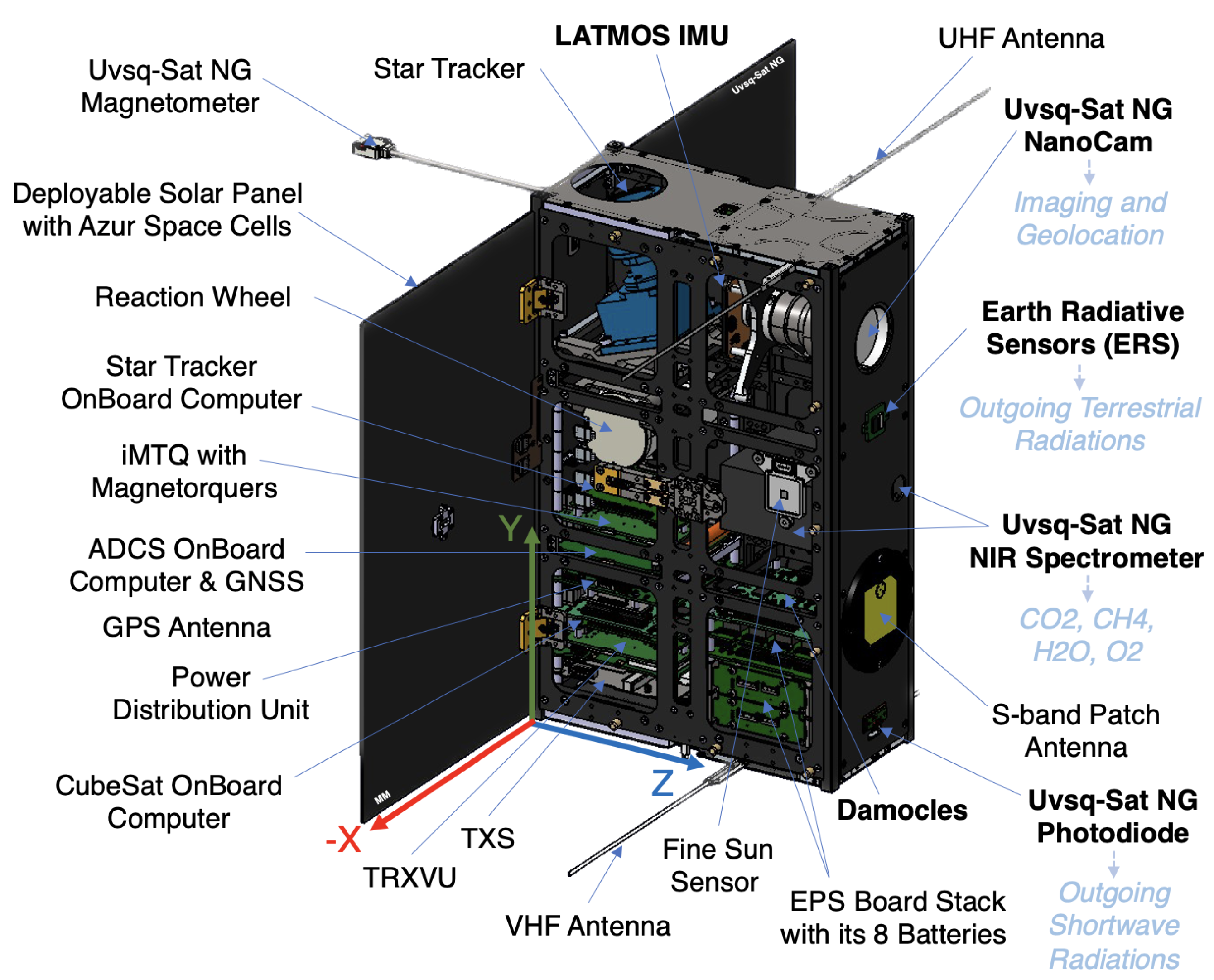
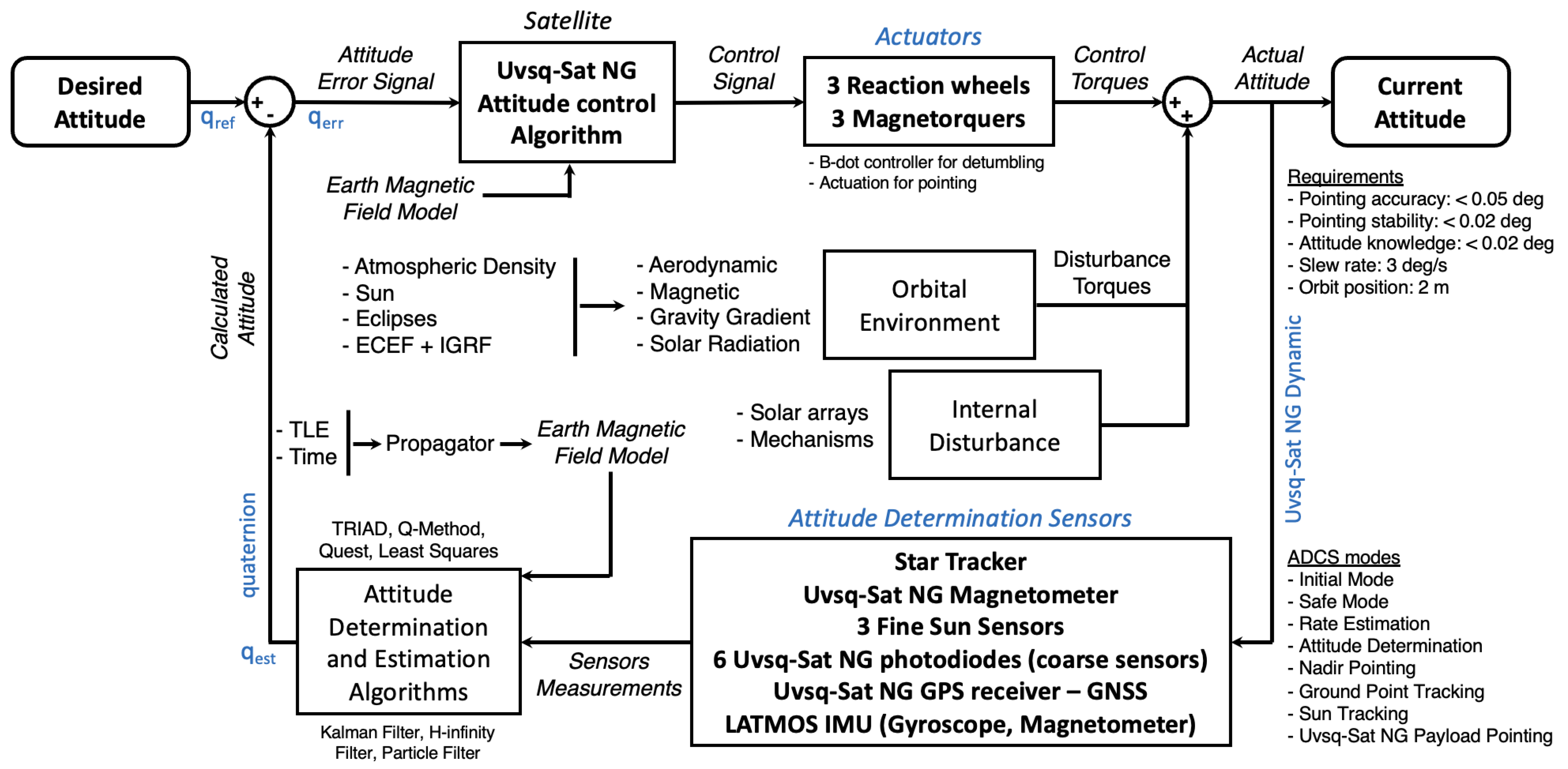

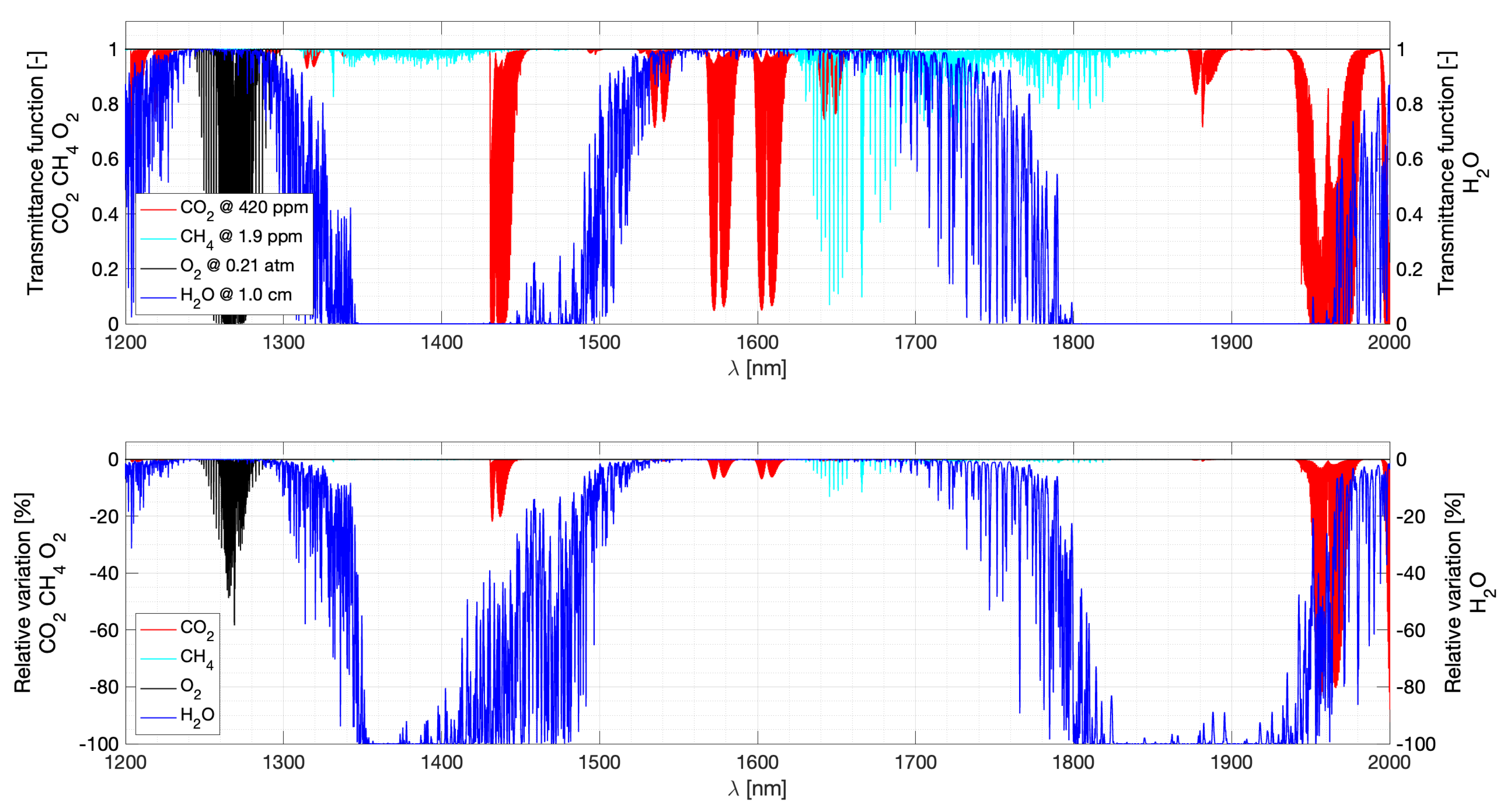
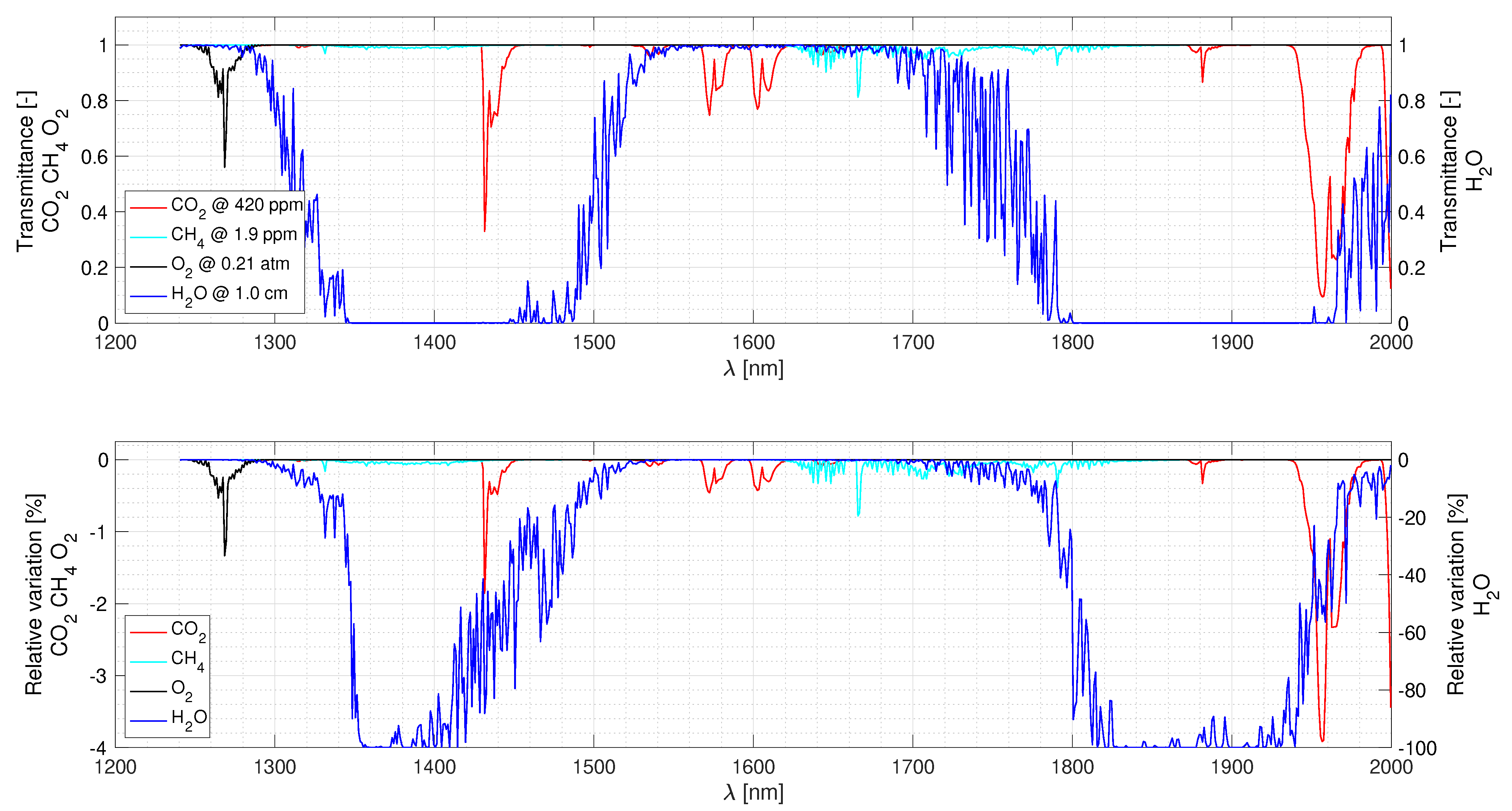
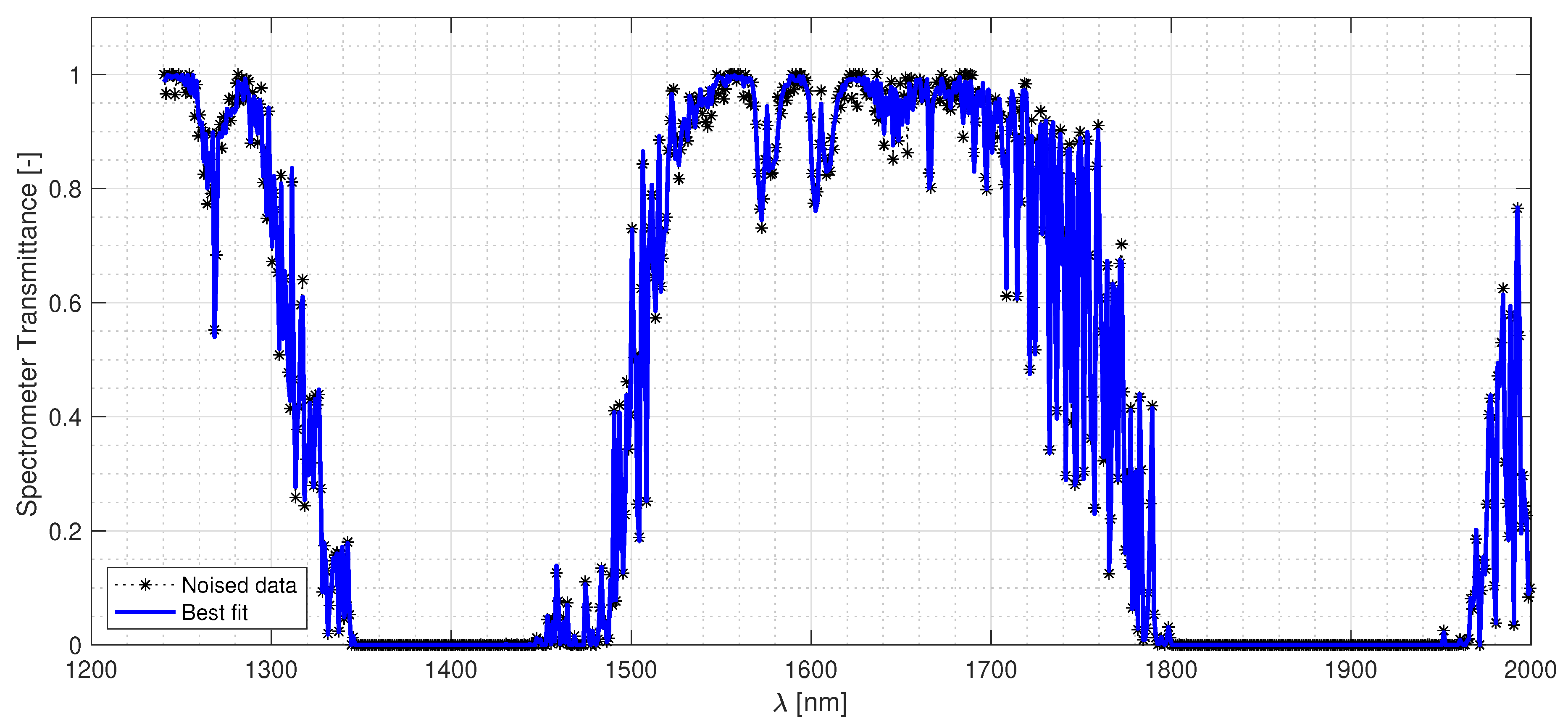
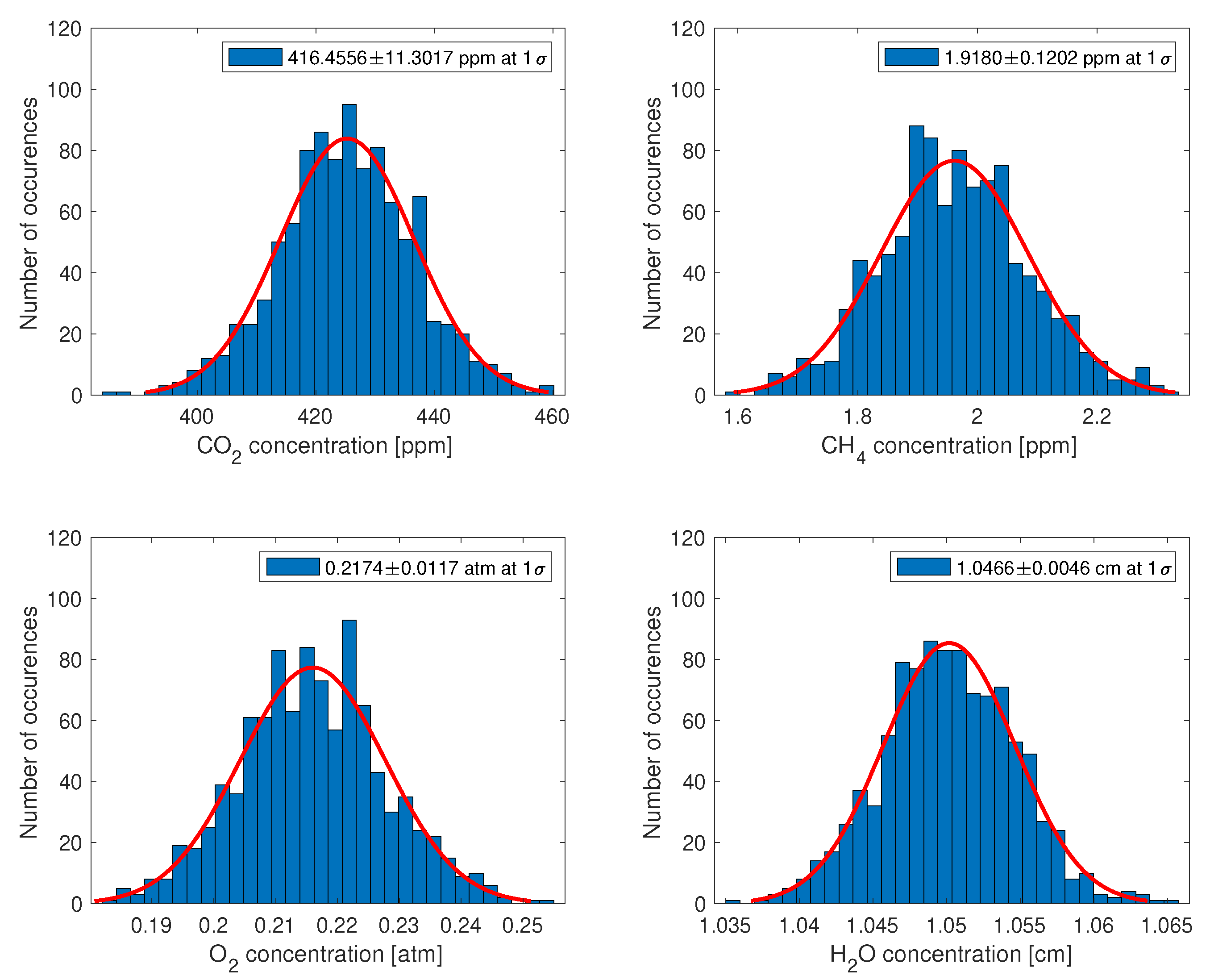
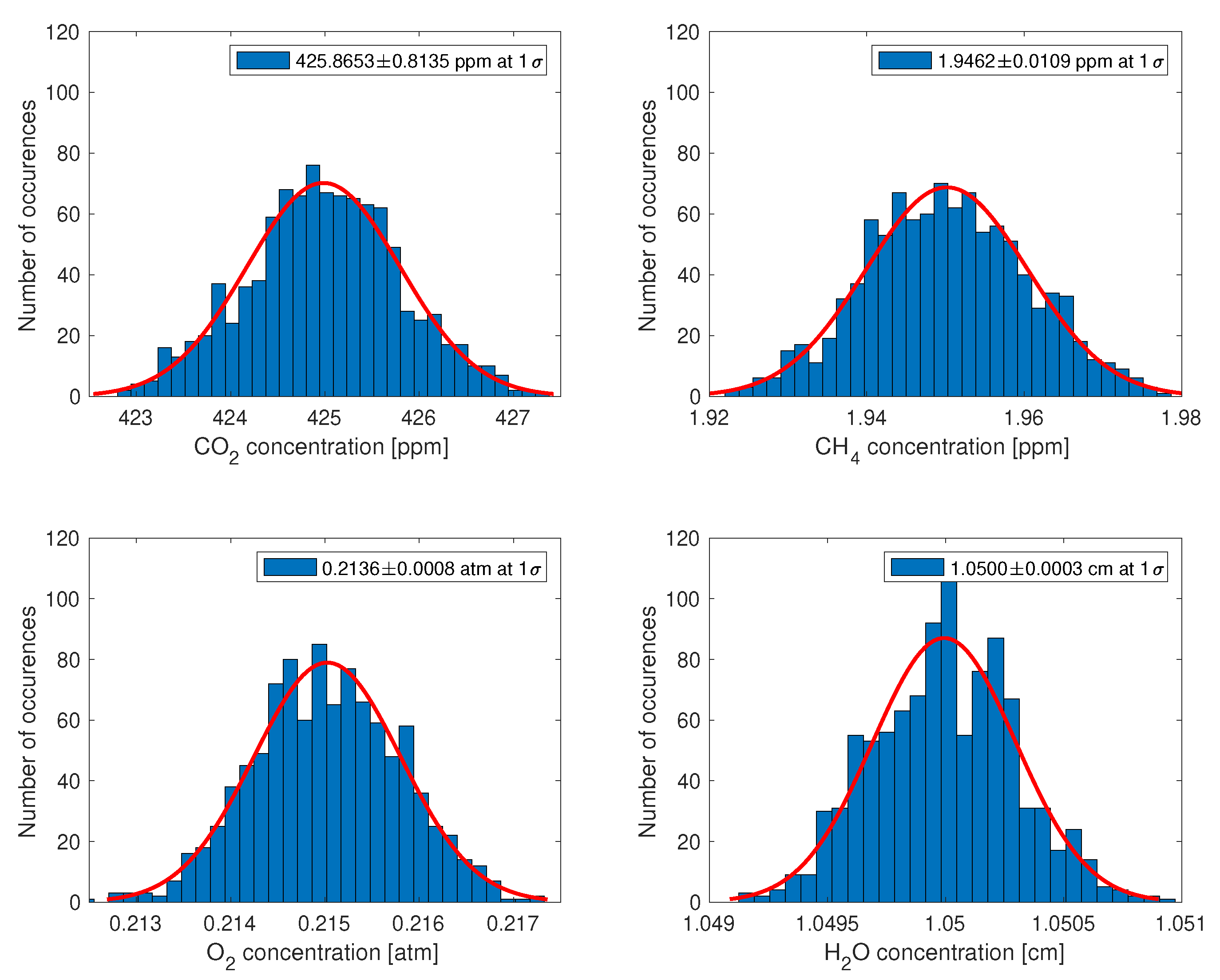
| Requirements for Uvsq-Sat—Launched on 24 January 2021 from Cape Canaveral, Florida, USA | ||||
| ECV | Absolute accuracy | Stability per year | Spatial resolution | Temporal resolution (global map) |
| OSR | ±10.00 Wm | ±5.00 Wm | 2500 km per element | 30 days with one CubeSat |
| OLR | ±10.00 Wm | ±1.00 Wm | 2500 km per element | 30 days with one CubeSat |
| Requirements for Inspire-Sat 7—Launched on 15 April 2023 from Vandenberg, California, USA | ||||
| ECV | Absolute accuracy | Stability per year | Spatial resolution | Temporal resolution (global map) |
| OSR | ±5.00 Wm | ±1.00 Wm | 2500 km per element | 10 days with two CubeSats |
| OLR | ±5.00 Wm | ±1.00 Wm | 2500 km per element | 10 days with two CubeSats |
| Requirements for Uvsq-Sat NG—Launch Date in 2025 or in 2026 | ||||
| ECV | Absolute accuracy | Stability per year | Spatial resolution | Temporal resolution (global map) |
| OSR | ±3.00 Wm | ±1.00 Wm | 2500 km per element | 5 days with three CubeSats |
| OLR | ±3.00 Wm | ±1.00 Wm | 2500 km per element | 5 days with three CubeSats |
| CO | ±4.0 ppm | ±1.0 ppm | 2–10 km per pixel | >30 days |
| CH | ±25.0 ppb | ±10.0 ppb | 2–10 km per pixel | >30 days |
| Requirements for a Hypothetical Satellite Constellation Named Terra-F—Horizon 2035 | ||||
| ECV | Absolute accuracy | Stability per decade | Spatial resolution | Revisit time |
| TSI | ±0.54 Wm | ±0.14 Wm | – | 24 h |
| OSR | ±1.00 Wm | ±0.10 Wm | 10–100 km per pixel | 3 h |
| OLR | ±1.00 Wm | ±0.10 Wm | 10–100 km per pixel | 3 h |
| EEI | ±1.00 Wm | ±0.10 Wm | – | 24 h |
| CO | ±1.0 ppm | ±1.5 ppm | 1–5 km per pixel | 3 h |
| CH | ±10.0 ppb | ±7.0 ppb | 1–5 km per pixel | 3 h |
| Parameter | Spectrometer | NanoCam | ERSs |
|---|---|---|---|
| Field of view | 0.15° | 13° | 180° |
| Aperture/surface | 15 mm | 32 mm | 10 × 10 mm |
| Spectral range | 1200–2000 nm | 390–690 nm | 0.1–3.0 m | 0.1–100.0 m |
| Image size | 1 × 256 pixels | 2048 × 1536 pixels | 1 × 1 element |
| Pixel size | 250 × 50 m | 3.2 × 3.2 m | 10 × 10 mm |
| Spectral resolution | 1 to 6 nm | – | – |
| Spatial resolution | <2 km per pixel | <30 m per pixel | 2500 km per element |
| Ground footprint | ∼5 km (Ø) | ∼77 km (diagonal) | ∼2500 km (Ø) |
| Properties | Value | Comments |
|---|---|---|
| Orbit | Sun-Synchronous Orbit (SSO) | Maximum altitude of 600 km, LTAN of 06:30 |
| Design life time | Minimum of 2 years in LEO | 3 years desired |
| Launch date | Between Q2 2025 and Q1 2026 | Launch vehicle: Falcon 9, Vega-C or Zéphyr |
| Launch adapter | QuadPack or EXOpod deployer | Payload mass up to 12 kg |
| CubeSat type | 6U XL | Easy-to-assemble modular design |
| Launch mass | 10.0 kg | Maximum with margins |
| Dimensions | 10.0 cm × 36.6 cm × 22.6 cm | Stowed along X, Y, and Z axes |
| 111.3 cm × 36.6 cm × 38.8 cm | Unstowed including all deployable elements | |
| Payloads | Two Earth Radiative Sensors (ERSs) | Outgoing terrestrial radiation measurements |
| Six Uvsq-Sat NG photodiodes | Outgoing shortwave radiation | |
| One Uvsq-Sat NG Spectrometer | Greenhouse gases monitoring | |
| One Uvsq-Sat NG NanoCam | Imaging and geolocation | |
| One Audio transponder | FM live retransmission (amateur radio) | |
| One LATMOS IMU | Three-axis accelerometer/gyroscope/compass | |
| Power | Up to 35 W generation at 1 AU | Two deployable solar panels on the Z− side |
| 52 solar cells on multiple sides | 3G30A solar cells provided by Azur Space | |
| Batteries of 90 Wh 16 V | 8 Panasonic batteries (NCR18650B) with heaters | |
| Power of 15.0 W generated | OAP in LEO with LTAN of 09:00 | |
| Power of 10.0 W consumed | Day average—nominal operations | |
| CDHS and OBC | CubeSat OnBoard Computer | Isispace |
| 400 MHz, 32-bit ARM9 | Processor | |
| 64 GByte | Storage | |
| IC/CAN/SPI/USART/UART | Data bus | |
| Thermal control system | Passive design | Coatings |
| 120 Ohms at 16 V | Heaters for batteries protection | |
| Communication | Uplink of 9.6 kbps | VHF (G3RUH FSK, Ax25) — 148.0 MHz |
| Uplink data of 0.3 Mbyte | Maximum during a day | |
| Downlink of 9.6 kbps|4.3 Mbps | UHF (BPSK) — 401.0 MHz | S-band — 2245 MHz | |
| Downlink data of 150.0 Mbyte | Maximum during a day with the S-band | |
| Contact station of ∼1 h per day | LATMOS and ACRI-ST ground stations | |
| Electric propulsion | 10 to 350 N of thrust | Enpulsion, Exotrail, or no subsystem |
| Pointing and ADCS | ADCS OnBoard Computer | Isispace, Cortex-M7 ARM micro-processor |
| Magnetorquer board (iMTQ) | Isispace | |
| Deployable magnetometer | iMTM from Isispace | |
| Fine Sun Sensor | Lens R&D | |
| Reaction Wheels | Astrofein | |
| Star Tracker and its OBC | Sodern (including Isispace processing unit) | |
| Three-axis magnetometer | Measurements of the local Earth magnetic field | |
| Three-axis magnetorquer | 0.2 Am magnetic dipole (per actuator) | |
| Six SLCD-61N8 photodiodes | Coarse estimation of the Sun’s direction () | |
| < 0.10 degree for all three axes | Absolute Performance Error (Roll, Pitch, Yaw) | |
| < 0.02 degree for all three axes | Performance Drift Error (Roll, Pitch, Yaw) | |
| Time and position | GNSS receiver | Novatel |
| GNSS patch antenna | Isispace | |
| ∼20 ns rms | Timing accuracy | |
| <2 m rms | Orbit position determination accuracy | |
| <0.03 ms rms | Orbit velocity determination accuracy | |
| Maximum slew rate of 10 s | Depending on CubeSat moment of inertia | |
| Modes | B-dot mode | Detumbling phase |
| Scientific modes | Nadir, zenith, Earth’s limb, Sun, deep space |
| Satellite Side | Element |
|---|---|
| X+ | 8 Azur Space solar cells |
| One hold-down-and-release mechanism of the Z−/X+ deployable panel | |
| One Fine Sun Sensor and one Uvsq-Sat NG photodiode | |
| X− | 8 Azur Space solar cells |
| One hold-down-and-release mechanism of the Z−/X− deployable panel | |
| One Fine Sun Sensor and one Uvsq-Sat NG photodiode | |
| Y+ | One Star Tracker aperture |
| One Uvsq-Sat NG photodiode | |
| Y− | 4 Azur Space solar cells |
| One Uvsq-Sat NG photodiode | |
| Z+ | Uvsq-Sat NG NIR Spectrometer aperture |
| Uvsq-Sat NG NanoCam aperture | |
| 2 Earth Radiative Sensors | |
| S-band patch antenna | |
| One Uvsq-Sat NG photodiode | |
| Z− | The Z−/X+ deployable panel with 16 Azur Space solar cells |
| The Z−/X+ deployable panel with 16 Azur Space solar cells | |
| One GNSS patch antenna | |
| One deployable Uvsq-Sat NG magnetometer | |
| One Fine Sun Sensor and one Uvsq-Sat NG photodiode |
| Uvsq-Sat NG NIR Spectrometer Spectral Resolution: 1 nm | |||||||
| SNR | 50 | 100 | 250 | 500 | 1000 | 2000 | 5000 |
| CO [ppm] | 10.998 | 5.602 | 2.204 | 1.130 | 0.575 | 0.277 | 0.110 |
| CH [ppb] | 125.028 | 66.209 | 25.245 | 12.302 | 6.625 | 3.108 | 1.294 |
| O [Ratio] | 11.024 | 5.921 | 2.433 | 1.165 | 0.636 | 0.299 | 0.120 |
| HO [cm] | 4.746 | 2.271 | 0.877 | 0.441 | 0.207 | 0.114 | 0.045 |
| Uvsq-Sat NG NIR Spectrometer Spectral Resolution: 6 nm | |||||||
| SNR | 50 | 100 | 250 | 500 | 1000 | 2000 | 5000 |
| CO [ppm] | 33.974 | 16.720 | 6.426 | 3.154 | 1.674 | 0.808 | 0.339 |
| CH [ppb] | 431.491 | 198.877 | 88.926 | 40.973 | 21.593 | 11.317 | 4.146 |
| O [Ratio] | 33.139 | 16.209 | 5.657 | 3.169 | 1.588 | 0.850 | 0.313 |
| HO [cm] | 12.474 | 5.933 | 2.518 | 1.236 | 0.609 | 0.284 | 0.124 |
Disclaimer/Publisher’s Note: The statements, opinions and data contained in all publications are solely those of the individual author(s) and contributor(s) and not of MDPI and/or the editor(s). MDPI and/or the editor(s) disclaim responsibility for any injury to people or property resulting from any ideas, methods, instructions or products referred to in the content. |
© 2023 by the authors. Licensee MDPI, Basel, Switzerland. This article is an open access article distributed under the terms and conditions of the Creative Commons Attribution (CC BY) license (https://creativecommons.org/licenses/by/4.0/).
Share and Cite
Meftah, M.; Clavier, C.; Sarkissian, A.; Hauchecorne, A.; Bekki, S.; Lefèvre, F.; Galopeau, P.; Dahoo, P.-R.; Pazmino, A.; Vieau, A.-J.; et al. Uvsq-Sat NG, a New CubeSat Pathfinder for Monitoring Earth Outgoing Energy and Greenhouse Gases. Remote Sens. 2023, 15, 4876. https://doi.org/10.3390/rs15194876
Meftah M, Clavier C, Sarkissian A, Hauchecorne A, Bekki S, Lefèvre F, Galopeau P, Dahoo P-R, Pazmino A, Vieau A-J, et al. Uvsq-Sat NG, a New CubeSat Pathfinder for Monitoring Earth Outgoing Energy and Greenhouse Gases. Remote Sensing. 2023; 15(19):4876. https://doi.org/10.3390/rs15194876
Chicago/Turabian StyleMeftah, Mustapha, Cannelle Clavier, Alain Sarkissian, Alain Hauchecorne, Slimane Bekki, Franck Lefèvre, Patrick Galopeau, Pierre-Richard Dahoo, Andrea Pazmino, André-Jean Vieau, and et al. 2023. "Uvsq-Sat NG, a New CubeSat Pathfinder for Monitoring Earth Outgoing Energy and Greenhouse Gases" Remote Sensing 15, no. 19: 4876. https://doi.org/10.3390/rs15194876
APA StyleMeftah, M., Clavier, C., Sarkissian, A., Hauchecorne, A., Bekki, S., Lefèvre, F., Galopeau, P., Dahoo, P.-R., Pazmino, A., Vieau, A.-J., Dufour, C., Maso, P., Caignard, N., Ferreira, F., Gilbert, P., d’Andon, O. H. F., Mathieu, S., Mangin, A., Billard, C., & Keckhut, P. (2023). Uvsq-Sat NG, a New CubeSat Pathfinder for Monitoring Earth Outgoing Energy and Greenhouse Gases. Remote Sensing, 15(19), 4876. https://doi.org/10.3390/rs15194876










